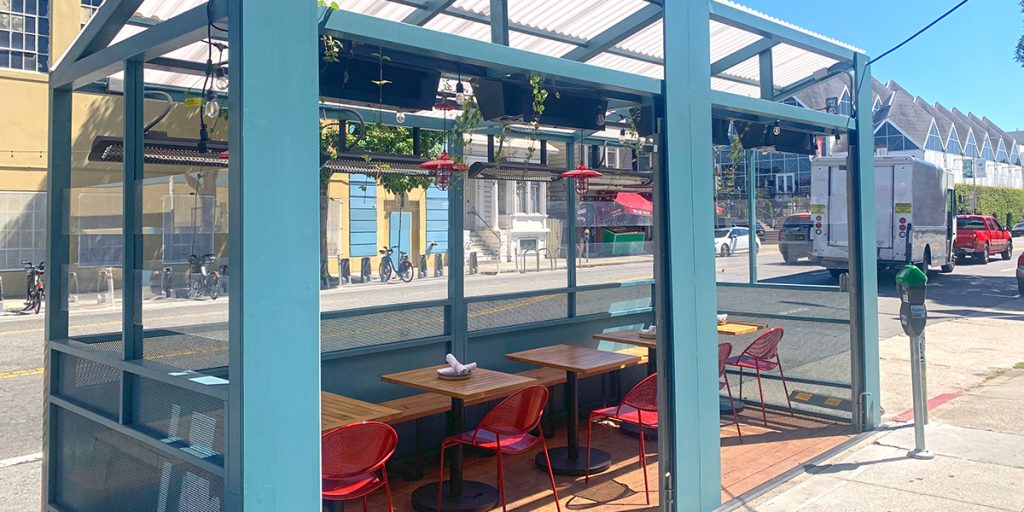Creating a menu of city standards for better outdoor dining guidelines
Prompted by pandemic restrictions as well as an increased interest in pedestrian-friendly streets, outdoor dining installations have rapidly grown in recent years. In New York, for instance, the city issued more than 12,000 outdoor dining permits to restaurants under its Open Restaurants program. In Los Angeles, more than 2,500 businesses have taken advantage of the LA Al Fresco program. Even smaller cities saw booms. Madison, Wisc., saw more than 175 restaurants take advantage of its Streatery program. Similar programs and efforts are ongoing across North America. While some of the pressures that prompted this shift have eased, the move from dining rooms to sidewalks or repurposed parking spaces seems here to stay.
As restaurants created new outdoor spaces, they often expanded into space in the public right of way previously used by pedestrians or vehicles. There, they joined many other users also seeking access to the same space—car owners, transit users, pedestrians, delivery drivers and more. Designing inclusive streets that safely balance these needs has become a defining challenge of modern transportation planning. At the same time, many cities are dealing with fiscal challenges that require them to do more with fewer resources, complicating the pressure to oversee these varying demands.
In many cities, initial outdoor dining programs were facilitated through emergency regulations and temporary permits. But with these provisional regulations expiring, cities are now rolling out or considering new permanent guidelines. As these rules are developed, consistency and ease of implementation should be top of mind. The recent experience of the city of Sacramento, Calif. offers a good example.
Permanent and consistent engineering designs
Like many cities, Sacramento restaurants created new and often impromptu outdoor dining options in response to COVID-19-related indoor dining restrictions. The city initially authorized them through emergency regulations and temporary permits. But seeing the popularity of outdoor dining options, and with continued intermittent indoor restrictions, the city sought more permanent regulations that ensure quality designs, incorporate safety features and follow accessibility guidelines.
An earlier version of city standards for these installations had been developed as part of a prototype program in 2014. But the guidelines were complex—the manual was 61 pages long—and as a result were never widely used. When the pandemic necessitated quick action, emergency regulations fast-tracked approvals, but these guidelines required improvement in addressing accessibility and quality standards. The city wanted a better option as it moved toward permanent regulations in its Al Fresco Dining Program.
The city, with the help of HDR, conducted extensive stakeholder engagement, researched programs in other cities and eventually created a series of civil, structural and electrical design templates for businesses. These templated concepts meet guidelines for accessibility and public safety while also providing customization options for businesses. An interactive website allows restaurants to choose from a menu of civil and structural design concepts to find the one that fits their location and needs. Business owners can combine provided layouts with different design choices and a construction estimate is provided for each. For instance, if an owner wants to design a seating area in the street with an elevated base and a wood planter wall, the city estimates it will cost $27,000-$32,000. An optional wood or steel canopy can add $10,000-$50,000. Owners can download free engineering layouts for all concepts, providing a head start on design.
Better for cities, better for businesses
This approach of providing prototypes provides a quick back-of-the-napkin estimate for businesses that may be unsure of the cost of installing outdoor dining. It also speeds the permitting process as the design concepts have been pre-approved by the city. Businesses are still welcome to create their own custom designs for outdoor dining, following a streamlined set of guidelines. But the city also now provides an easier, quicker option for businesses. More than 60 restaurants in Sacramento have already begun the application process.
Moving forward, Sacramento expects a number of benefits as a result of its Al Fresco Dining program:
- New dining options that activate the public right-of-way to create more vibrant neighborhoods and businesses that draw residents and visitors from across the region.
- Revenue for the city, provided by new businesses leasing space in the public right-of-way
- Improved accessibility compliance, as new designs assure adherence to Americans with Disabilities Act standards
- Improved compliance and adoption by small businesses, who are provided conceptual engineering plans and estimates to aid in their decision making.
As demand for curb space continues to rise, many cities could benefit from similar approach, adding consistency to outdoor dining guidelines and making applying for these permits a simpler process for business. Cities are grappling with many competing demands for their right of way, from many sectors and users. Clear, simple guidelines such as those in Sacramento can help streamline decisions on how businesses can participate in this process. At the same time, as cities seek to create more safe, beneficial and inclusive spaces, initiatives like new al fresco dining guidelines can be a launching point to larger conversations about how cities can better activate and manage their right of way, not only for businesses and customers, but all residents and visitors.
Other cities are already paying attention to the success seen in Sacramento. Done right, new guidelines can be a win for all, with new revenue for cities, new amenities for the public and new opportunities for businesses to reach customers.
Tham Nguyen is HDR’s Southwest transportation planning lead and Glenn Armstrong is an HDR project manager who oversaw development of the Sacramento Al Fresco Dining Program guidelines.




















